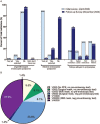Evolution of International Pediatric Endoscopic Practice Changes During the Coronavirus Disease 2019 Pandemic
- PMID: 35185114
- PMCID: PMC9172578
- DOI: 10.1097/MPG.0000000000003416
Evolution of International Pediatric Endoscopic Practice Changes During the Coronavirus Disease 2019 Pandemic
Abstract
Objectives: The coronavirus disease 2019 (COVID-19) pandemic has drastically altered endoscopic practices. We initially reported the international impact of COVID-19 on pediatric endoscopic practice. This follow-up study aimed to assess changes 7 months following the initial survey to delineate practice change patterns as the pandemic evolved.
Methods: Pediatric gastroenterologists who responded to the initial survey were re-surveyed seven months later using Research Electronic Data Capture (REDCap). The survey recorded information on changes in pediatric endoscopic practice patterns, including COVID-19 screening and testing processes and personal protective equipment (PPE) utilization. Additionally, endoscopists' risk tolerance of COVID-19 transmission was evaluated.
Results: Seventy-five unique institutions from 21 countries completed surveys from the 145 initial responses (51.7% response rate). Procedural volumes increased at most institutions (70.7%) and most were performing previously postponed cases (90.7%). Ninety-seven percent of institutions were performing pre-endoscopy screening with 78.7% testing all patients. Many institutions (34.7%) have performed procedures on COVID-19 positive patients. There was significantly less PPE reuse (P < 0.05) and fewer institutions recommending full PPE for all endoscopies (43.2% vs 59.2%, P = 0.013). Overall, pediatric endoscopists' risk tolerance of COVID-19 transmission is low.
Conclusions: This is the first survey to highlight the evolution of pediatric endoscopic practices related to the COVID-19 pandemic, underscoring the need for ongoing pandemic-related guidance for pediatric endoscopic practice.
Copyright © 2022 by European Society for Pediatric Gastroenterology, Hepatology, and Nutrition and North American Society for Pediatric Gastroenterology, Hepatology, and Nutrition.
Conflict of interest statement
The authors report no conflicts of interest.
Figures

Similar articles
-
The use of personal protective equipment in endoscopy: what should the endoscopist wear during a pandemic?Expert Rev Gastroenterol Hepatol. 2021 Dec;15(12):1349-1359. doi: 10.1080/17474124.2021.2011213. Epub 2021 Dec 20. Expert Rev Gastroenterol Hepatol. 2021. PMID: 34821190 Review.
-
Impact of the COVID-19 pandemic on gastrointestinal endoscopy activity in France.Endoscopy. 2020 Dec;52(12):1111-1115. doi: 10.1055/a-1201-9618. Epub 2020 Jul 8. Endoscopy. 2020. PMID: 32557489 Free PMC article.
-
Gastrointestinal endoscopic practice during COVID-19 pandemic: a multi-institutional survey.Rom J Intern Med. 2021 May 8;59(2):166-173. doi: 10.2478/rjim-2020-0038. Print 2021 Jun 1. Rom J Intern Med. 2021. PMID: 33826812
-
A Questionnaire-Based Survey on the Impact of the COVID-19 Pandemic on Gastrointestinal Endoscopy in Asia.Digestion. 2022;103(1):7-21. doi: 10.1159/000520287. Epub 2021 Nov 10. Digestion. 2022. PMID: 34758472 Free PMC article.
-
BSGIE survey on COVID-19 and gastrointestinal endoscopy in Belgium : results and recommendations.Acta Gastroenterol Belg. 2020 Apr-Jun;83(2):344-354. Acta Gastroenterol Belg. 2020. PMID: 32603061 Review.
Cited by
-
Impact of the Coronavirus Disease 2019 Pandemic on Pediatric Gastrointestinal Endoscopy: A Questionnaire-based Internet Survey of 162 Institutional Experiences in Asia Pacific.Pediatr Gastroenterol Hepatol Nutr. 2023 Nov;26(6):291-300. doi: 10.5223/pghn.2023.26.6.291. Epub 2023 Oct 30. Pediatr Gastroenterol Hepatol Nutr. 2023. PMID: 38025493 Free PMC article.
-
The COVID-19 Pandemic Impact on Pediatric Endoscopies in a Single Center.Glob Pediatr Health. 2022 May 31;9:2333794X221100948. doi: 10.1177/2333794X221100948. eCollection 2022. Glob Pediatr Health. 2022. PMID: 35664049 Free PMC article.
References
-
- Tam SS, Picoraro JA, Gupta SK, et al. . International Pediatric Gastroenterology COVID-19 Alliance. Changes to pediatric gastroenterology practice during the COVID-19 pandemic and lessons learned: an international survey of division and group heads. Gastroenterology 2021; 161:1052–1055. - PMC - PubMed
-
- Ranney ML, Griffeth V, Jha AK. Critical supply shortages - the need for ventilators and personal protective equipment during the Covid-19 pandemic. N Engl J Med 2020; 382:e41. - PubMed
Publication types
MeSH terms
LinkOut - more resources
Full Text Sources
Medical

